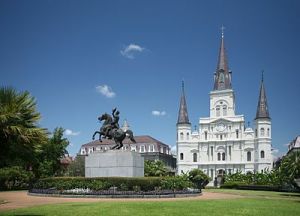In 1541 a Spanish explorer, Hernando de Soto, discovered the Mississippi River. In 1682 Robert de La Salle sailed down the Mississippi and claimed Louisiana for France. In 1721 an engineer laid the city grid of New Orleans. The city quickly became populated with ships of criminals and prostitutes from the homeland and African slaves. In 1763 the French lost the Seven Years War and quickly ceded Louisiana back to Spain before signing the formal Treaty of Paris with Great Britain. Spain ceded Louisiana to Napoleon’s France in 1800, but the Americas weren’t really his thing. Only three years later, the United States purchased Louisiana from Napoleon for $15 million. In 1812 Louisiana was admitted to the Union. New Orleans became an even more important port when steamboats began navigating the Mississippi bringing grain and lumber from the heartland. New Orleans was the biggest city in the South with around 170,000 residents during the Civil War and its complete destruction was critical to a Union victory.
Every time the city’s recovered from the last devastation it was brought back to its knees by another brutal battle for control, an epic fire, or other natural disaster. Despite this sad pattern, the residents always rebuilt bringing new technologies, new styles, and a little bit of the new culture to every restoration.
On our first full day in New Orleans, we will explore the history of the French Quarter to learn about all things French and French Creole before expanding to the other cultures and neighborhoods. We are early risers and unfortunately, my agenda items do not open until 9:30 am. To make the most of our morning we will go for a quick jog along Royal Street. The buildings on Royal Street were built in the early 1800s and have been painstakingly restrained for centuries. They now house high-end antique stores and fancy restaurants. On the run we will scout breakfast opportunities along the route. Hopefully, we will find a smaller restaurant to compare the coffee and beignets to Café Du Monde.
Our first official agenda item will be Mardi Gras exhibit at the Louisiana State Museum (Open 9:30 am-4:00 pm, $3 per adult). Although I don’t think I am completely ready for the full Mardi Gras experience, I would like to get a little taste. The exhibit includes history, ballgowns, costumes, and behind the scenes details about police protection and parade logistics.
Then we will wander through Jackson Square and make our way to another Louisiana State Museum operated exhibit, the Jackson House. The lavish furniture in the Jackson House (Open 10:00 am-4:30 pm, $3 per adult) shows how the common folk lived in the Antebellum Era. There is no better way to learn about history than to see how the people went about their everyday tasks. Plus, I like looking at other people’s homes and pretty furniture!
For lunch we will meander over to the Napoleon House Café and Bar for muffuletta sandwiches. Click here to see how Emeril Lagasse makes his take on the classic. Since we are in New Orleans AND on vacation, I think a lunch time cocktail is only appropriate. We will be in luck – the Napoleon House is famous for the Pimm’s Cup cocktail (Pimm’s #1, lemonade, and 7up, garnished with cucumber). The Napoleon House got its name when the home’s first occupant (the mayor of New Orleans) offered his residence to Napoleon during his exile. The restaurant has been owned and operated by the same family since 1914. Yum!
More on our afternoon later!





shras789
Very interesting subject, I like it alot
Pingback: The Big Easy (2) « Sherry's Space
wanderoneday
New Orleans is one of my favorite travel destinations of all time. Cafe du Monde has a solid reputation for a reason and it is worth it to eat there – just be sure to bring cash (they don’t take credit cards). Also, you don’t have to wait in the ‘tourist line’ that forms – you can go in through the entry way on Decatur Street and sit wherever you see an open seat. The praline shop down the street has great free samples too.
Also, if you’re looking for delicious, authentic Cajun cooking in an historic setting, try the Gumbo Shop on St. Peter St. Afterwards, I highly recommend going to Pat O’Brien’s Piano Bar for a Hurricane – it gets pretty crowded but it is my favorite bar in America!